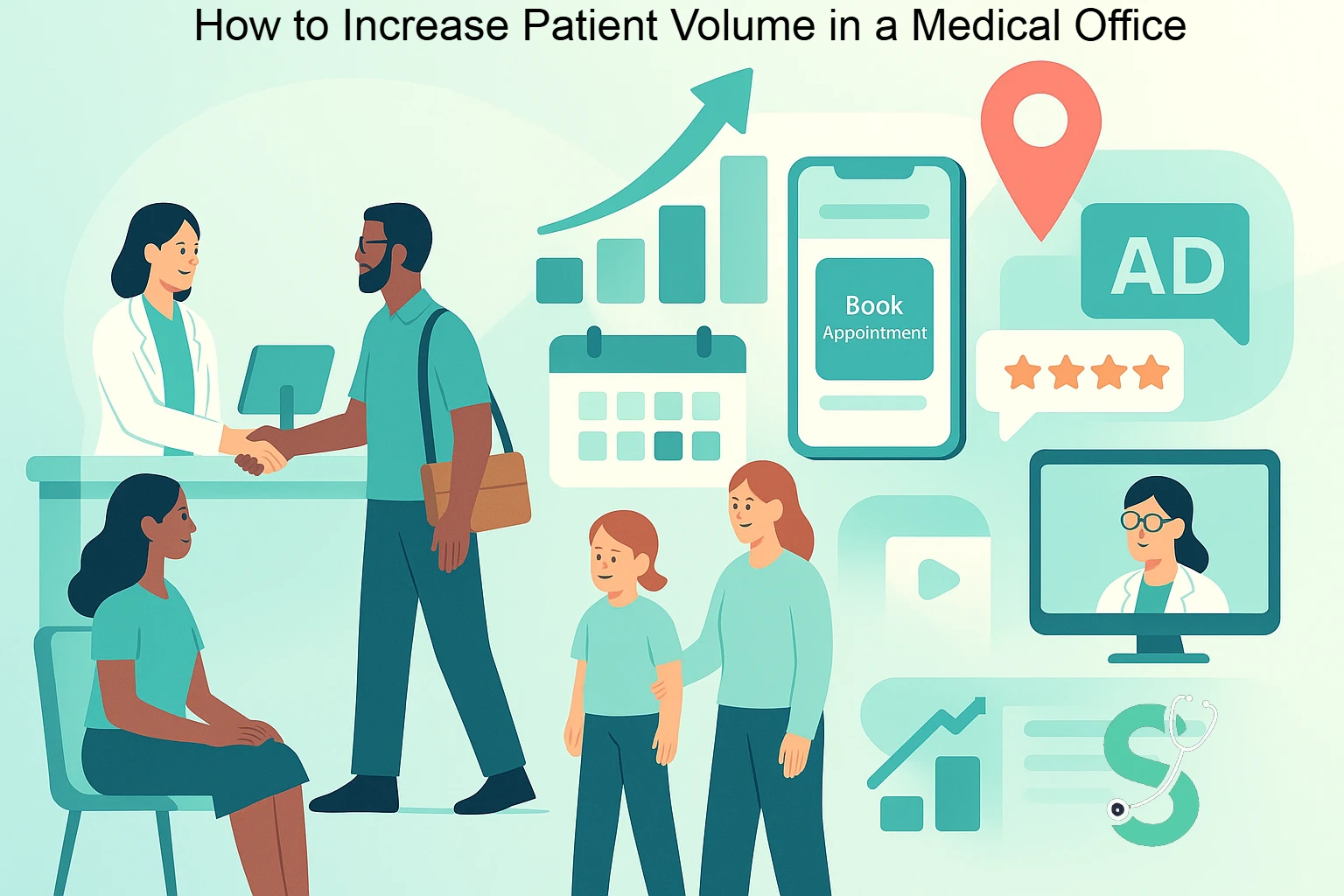In this article on How to Increase Patient Volume in a Medical Office, you’ll learn how to build a predictable growth engine—from winning local search and capturing high-intent patients to frictionless online scheduling, targeted Google and social ads, automated recalls that boost retention, and an upgraded in-office experience that earns five-star reviews.

We’ll also cover referral and community partnerships, simple workflows your team can implement this week, and the key metrics that prove it’s working (TNAA, review velocity, and cost per booked appointment). Whether you’re a primary care clinic or a multispecialty practice, use this playbook to drive sustainable growth without overwhelming your staff.
Table of Contents
How Medical Offices Increase Their Patient Volume in 2025
For medical offices, increasing patient volume means more than just filling appointment slots. It’s about creating a reliable system that attracts new patients, improves retention, and ensures your practice is seen as a trusted source of care in the community.
Unlike hospitals or urgent care centers, a medical office thrives on consistency—patients booking regular checkups, chronic condition management, and preventive care visits. The challenge is making sure those patients choose you and keep coming back.
Do you run a larger facility? Learn How to Increase Patient Volume in a Hospital
Why Patient Growth Is Vital for Medical Offices
A medical office often serves as the first point of contact for healthcare. Patients rely on you for:
- Preventive care such as physicals and screenings
- Management of chronic conditions like diabetes or hypertension
- Referrals to specialists when needed
- Ongoing doctor–patient relationships
If your practice isn’t proactive about visibility and engagement, patients may drift toward larger hospital networks or competitors.
Read How to Increase Patient Volume in 2025
Proven Ways to Increase Patient Volume in a Medical Office
1. Build a Strong Online Presence with Local SEO
Most patients start their journey with a search query like “primary care doctor near me” or “family medical office in [city].” If your practice doesn’t appear, you are invisible to potential patients.
Steps to improve local SEO:
- Claim and optimize your Google Business Profile with updated hours, services, and photos
- Create dedicated pages for services such as preventive care, women’s health, or chronic care management
- Publish patient-focused blog articles answering common health questions
- Encourage patients to leave Google reviews after each visit
When your medical office ranks higher locally, you capture patients at the moment they are searching for care.
Quick Read: How to Market a Mental Health Clinic in 2026
2. Offer Convenient Scheduling Options
Patients are less likely to book if scheduling is difficult. Convenience drives patient acquisition and retention.
- Add online appointment booking directly on your website
- Offer same-day or next-day availability for urgent needs
- Allow patients to request prescription refills online
- Provide telehealth visits when in-person care is not necessary
A smooth scheduling experience shows patients that your office respects their time and makes care accessible.

3. Run Targeted Advertising Campaigns
Advertising can help medical offices reach new patients quickly.
- Google Ads target searches like “family doctor near me” or “urgent care alternative.”
- Facebook and Instagram Ads highlight services such as wellness checkups, vaccinations, or chronic condition management.
- Retargeting ads remind website visitors who didn’t book an appointment to come back and schedule.
By targeting ads around your office’s specialties, you ensure marketing dollars go toward patients most likely to book.
4. Focus on Patient Retention and Relationships
A large percentage of patient volume comes from existing patients returning for regular visits. Yet many practices lose patients due to lack of communication.
Retention strategies for medical offices include:
- Automated appointment reminders by text or email
- Preventive care reminders such as annual checkups and screenings
- Follow-up calls after important visits to improve satisfaction
- Wellness newsletters with health tips and updates about your practice
These touchpoints strengthen relationships and remind patients to stay consistent with their care.
Quick Read: Guide to Online Appointment Scheduling for Doctors in 2025
5. Improve Office Efficiency and Patient Experience
Even if you attract new patients, they won’t stay if their in-office experience is poor. Long wait times, poor communication, and rushed visits reduce trust.
Ways to improve experience:
- Streamline check-in with digital forms
- Reduce wait times through better scheduling
- Train staff to greet and guide patients with care
- Provide clear post-visit instructions and follow-up options
When patients feel respected and cared for, they are more likely to return and recommend your office to others.
You’ll love this article: HIPAA Compliant Marketing Solutions for Doctors
6. Build Referral and Community Partnerships
Strong referral networks can help your medical office grow quickly.
- Partner with specialists and create smooth referral systems
- Join local community health fairs or wellness events
- Connect with local employers to offer workplace health programs
- Encourage word-of-mouth referrals by creating a simple referral reward system
Community engagement builds your reputation as a trusted local provider.

Explore: How to Increase Patient Volume in a Dental Office
Key Metrics for Patient Volume Growth
To track whether your strategies are working, measure:
- New patient appointments per month
- Percentage of patients returning for annual checkups
- Average wait time from booking to appointment
- Patient satisfaction scores and online review ratings
A steady increase in these numbers shows that your patient growth strategies are paying off.
Operational Tactics That Move the Numbers
Reduce no-shows without extra spend. Implement two-step reminders (72h and 24h) with self-serve rescheduling, offer telehealth as a fallback, confirm insurance in advance, and backfill cancellations from a waitlist. Aim for a 5–8% no-show rate.
Set a sensible starter paid media budget. Allocate $1.5k–$3k/month to Google Ads for “near me” and core service terms, plus $500–$1k/month to Meta for wellness and recall campaigns. Drive traffic to single-service landing pages and target $80–$150 cost per booked appointment depending on market.
Track ROI the HIPAA-safe way. Use HIPAA-ready forms with a BAA, consented call tracking, and server-side conversions that pass only non-PHI events. Measure booked and kept appointments (not just clicks) and reconcile results against provider schedules weekly.
Be intentional with insurance mix. Model payer performance before expanding. If growth is the goal, add one high-volume plan at a time and monitor margins and throughput—sometimes fewer plans + better access delivers stronger profitability.
Serve bilingual communities. If ≥10% of your market speaks another language, publish full Spanish (or relevant) service pages, enable multilingual Google Business Profile attributes, and run matching ad groups. Expect a lift in conversion rates.
Tailor offers by specialty. The core of How to Increase Patient Volume in a Medical Office holds, but positioning shifts: pediatrics (school/sports physicals, same-day sick), women’s health (well-woman care, prenatal pathways), multi-specialty (service hubs with clear routing and specialty-specific booking).
Build landing pages that convert. Use a city-specific headline, list insurance accepted, show provider photos, and include social proof (star rating + review count). Embed online booking, add click-to-call and a map/directions, include a concise FAQ, and keep page speed ≤2 seconds.
Final Thoughts on Increasing Patient Volume in a Medical Office
Growing patient volume in a medical office comes down to three things: visibility, convenience, and trust. By improving your online presence, making scheduling easy, running targeted ads, and strengthening patient relationships, you can create sustainable growth.
Stethon digital marketing helps medical offices build strong community ties and consistently delivers excellent patient experiences will not only increase volume but also ensure long-term stability.
Frequently Asked Questions
How can an independent medical office compete with hospital-owned clinics?
Differentiate on access and experience: shorter TNAA, online booking everywhere, transparent insurance info, and provider bios with trust signals (ratings, languages). Pair this with hyper-local SEO and high-intent Google Ads.
Which service pages should we build first to rank and convert?
Start with New Patient Exams, Annual Physicals, Chronic Care Management, and one or two high-demand niches (e.g., Women’s Health, Pediatrics). Add “[City] + service” to titles/H1s and include insurance accepted, FAQs, and a visible Book Now module.
What makes a Google Business Profile actually convert?
Primary category set correctly, booking link enabled, provider photos, services listed, insurance noted, Q&A answered, and consistent hours (including holiday hours). Aim for a 4.7+ rating and respond to every review within 48 hours.
How many Google reviews do we need—and how fast?
Target 40–60 fresh reviews per location per year (3–5/month). Use post-visit SMS with a direct link and rotate asks by provider to keep velocity steady and natural.
What’s a healthy online booking conversion rate for clinics?
A solid benchmark is 5–12% of organic/paid visitors booking or requesting an appointment. To hit it: 3-click path, show next available times, insurance badges above the fold, and autofill for returning patients.
What TNAA should we aim for?
For new patients, ≤ 7–10 days. For established acute, 1–3 days. If you’re above that, protect same/next-day slots, extend hours one evening a week, and rebalance provider templates.
